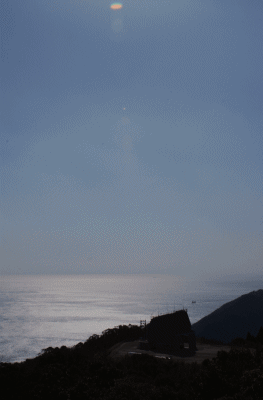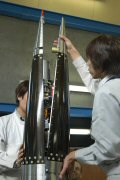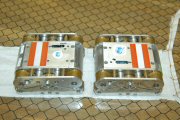Furoshiki & RobySpace

How to build very large structures in space? This is the problem addressed on this project. One of the potentially most interesting applications are very large aperture antennas, e.g. radar-frequency antennas in geostationary orbit.
FUROSHIKI - A JAPANESE CLOTH IN THE SKY
The name 'furoshiki' comes from a Japanese cloth used to wrap up small possessions and the idea behind is to deploy a thin film or a net in space on which the antenna elements are positioned.
For this purpose, a Japanese sounding rocket experiment was launched on January 22, 2006 from the Uchinoura JAXA/ISAS launch site in the south of Japan, carriying out three experiments all three never tried in space:
First, three daughter satellitels detached from the mother section and extended between them a very thin net of triangular shape of a bout 130 squaremeters.
Second, at the same time, the mother (in the middle of the net) and daugther satellites received a pilot signal from a ground station and accordingly "tuned" their respective microwave antenna elements to "retrodirectively" direct their collective beam towards the ground receiving site.
Third, two tiny robots, RobySpace Junior 1 and 2 got their signal to detach from and leave their launch configuration box in the mother satellite and tried to crawl on the free floating net in a controlled manner each towards one daugther section.
While the deployment of the net and the daughter sections are made by Prof. Nagasuka (University of Tokyo) and the retrodirective wireless power transmission experiment is conducted by Prof. Kaya (University of Kobe), the two robotic crawlers are from Europe.
ROBYSPACE JUNIOR - A CAREER THAT BEGAN WITH SOCCER
The two small robots intended to demonstrate the ability to move on an highly unstable and unpredictable, very thin and loose net under microgravity conditions. They are constructed by the team of Prof. Kopacek from the Vienna University of Technology with the support of the Advanced Concepts Team.
Bernhard Putz, responsible for their design took advantage of the experience gained during several years of very successful robot soccer games. The viennese team regularily ends up in the final of European and World championships and is renouned for its innovative and robusts designs.
Different design concepts of the robotic crawlers were tested at prototype level first on ground and then during two Japanese parabolic flight campaigns.
TOWARDS LARGE ANTENNAS

The exiting, University-led experiments have a serious background: several space applications require large structures, as e.g. obtaining high resolution from large distrance. All available techniques have their limitations: inflatable structures, manual or robotic assembly of constructions in space, rigid deployables, formation flying. The Furoshiki concept is taking advantage of formation flying properties, but by adding some additional elements and stability: the satellites are still loosely connected and very small independent (wireless communication, onboard PV power supply and processing units) antenna elements could be launched together and then find their respective position on the net and eventually reconfigure automatically to optimised configurations.
RESULTS OF THE FLIGHT EXPERIMENT
The Japanese rocket carrying the spider robots blasted off on 22 January, propelling the experiment into space [sequence from the launch].

From the video and the data received, the net deployed perfectly, the retrodirective antenna system worked and at least one of the two robots has left his garage and crawled on the free floating net into the visibility of one of the cameras.
A full analysis of all the data is currently ongoing. One aspect to be analysed in more detail is the behaviour of the net during its deployment and after, during its stabilisation, clearly the most challenging part. In parallel, two studies are currently performed by the ACT with the University of Glasgow and the Stockholm based Royal Institute of Technology (see section on Ariadna studies) in order to simulate the behaviour of the net and better understand the its dynamics.
Based on this success and the full analysis of the test data, the next steps are in preparation. One of them would be to add small antennas to the spider robots, so that they can join in the transmitting and receiving parts of the test, and have more onboard autonomy, intelligent visual systems, inter-robotic communication etc… . Another one is to prepare together with the Japanese partners a system that would test instead of a controlled active deployement a more passive centrifugal deployment of the net.